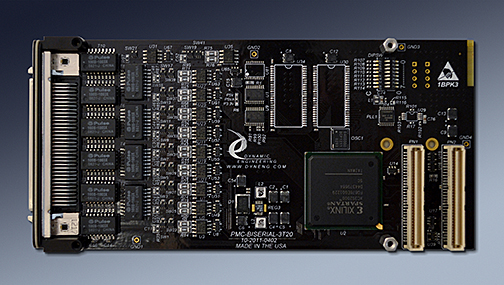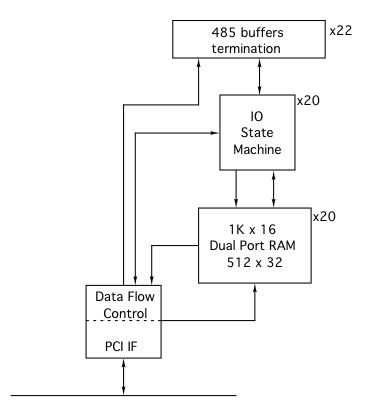








PMC-BiSerial 3T20
PMC Compatible Multi Function Interface with transformer coupling






















| Custom programmed interfaces are available. Please send us a timing diagram, and we can program one for you. Most interfaces can be adapted from our large library of designs within 1-2 weeks including the updated VHDL, Windows Driver, reference manuals etc. We can support on-site [ours] integration to help you get your application level software working. Alternatively choose one of the already completed versions and purchase off-the-shelf. Common requested and implemented interface types include: Manchester, Miller, SDLC, UART, Serial, Parallel, GPIO, COS, Custom, LADEE, NMS, Camera, Ternary, Low Speed, High Speed, Telemetry, Master & Target interactive IO, Adaptive |
|
| |
|
| 22 RS-485 / RS-422 / LVDS compatible IO are provided with transformer coupling on up to 20 of the IO. Any combination of transmit or receive channels can be created. LVDS and RS-485 can be mixed. RS-485 bandwidth is lower when mixed [16 Mbps]. Programmable termination. |
|
| |
|
| The IO is available via the PMC bezel connector - SCSI 68 position connector with latch block or thumbscrew style retainers. The differential IO is properly routed with impedance control, pitch, and space plus matched lengths across all of the pairs. |
|
| Up to 40 MHz RS485, and up to 100 MHz LVDS signaling supported [with transformers installed. The upper frequency for the LVDS in direct connect positions is greater than 200 Mhz. 4 channel software programmable PLL. Reference oscillator. Counters / Dividers / DCM for local clock control. |
|
| |
|
| PCI 33 MHz. operation Standard Target accesses, and "Channelized DMA"™ supported. "Channelized DMA"™ is a full DMA capability on each function in a multi-function implementation. Standard 32 bit operation supported. |
|
| PMC registers are read-writeable. Linux and Windows® drivers available. Design help for alternate OS implementations. | |
| An 8 bit "DIP Switch" is provided for user purposes. The DIP switch can be used to allow the application software to positively identify a PMC-BiSerial-3T20 in a multi-board implementation. The PCI bus enumerates the address which means the application software can´t rely on the address to always match up with a particular card. With the DIP switch the particular BiSerial can be identified and postive control over a particular asset provided. Could be important depending on what you are connected to. The switch can also be used for software control, a debugging aide or other user purposes. | |
| Software programmable interrupts on status, errors, completion of transfer, DMA, FIFO levels, custom events. Status can be polled for non-interrupt driven operation as well. |
|
| Separate FIFO´s / Dual Port RAM are provided for all channels. Internal FPGA Block RAM memory modules for fast access. Optional discrete FIFO´s -16M x 32 are available. |
|
| Xilinx Spartan III 2000 and 4000 models are installed based on client requirements. FLASH is used to program the FPGA. In many cases any feature updates can be sent to your facility to reprogram without down time. | |
| |
|
| +5 and 3.3V. 2.5V and 1.2V converted with on-board power supply. |
|
| Commercial Temperature is standard. Industrial [-40 <=> +85] is available. | |
| Standard [leaded] processing or ROHS compliant processing are available. See ordering options. | |
| Conformal Coating is available to support operation in condensing environments. | |
| |
|
| Standard Single PMC |
| PMC-BiSerial-3T20 is optimized for differential interfacing requirements. The FIFO memories and programmable interrupts off-load the CPU from most of the management other implementations require. FIFO access is optimized for the PCI bus further reducing overhead by speeding up the data transfer. On the IO side the PMC BiSerial has independent channel functions. Channels can operate at maximum rate in parallel. With the Spartan III "Channelized DMA"™ can be implemented and still have plenty of gates left for your application. |
|
| |
|
| PMC-BiSerial-3T20 is easily programmed to implement new functions. Many previously implemented "custom designs" are available too. Without the costs of schematic level design, layout, debugging etc. a modified PMC-BiSerial-3T20 will represent a large cost savings in your budget. With our large and growing VHDL library your function(s) may be close to complete when we start since we can modify existing implementations or repackage them as required. |
|
| |
|
| PMC-BiSerial-3T20 is easy to use. The registers are designed to be R/W without layering or other indirect control methods. Use the Dynamic Driver with Windows® or Linux or create your own. The HW manual has the full address and bit maps plus definitions for each function. In most cases the interfaces are "Point and shoot" - just fill the FIFO and set the start bit to get your custom protocol transmitting. The driver and user application reference software have built in utilities for parsing new PLL frequency files, loading the PLL, reading the switch, doing loop-back using DMA via the IO and between FIFO´s. Built in loop-back capabilities and engineering kits help with integration into your system. We can write a custom Windows® or Linux driver for you. |
|
| |
|
| Dynamic Engineering works to keep the PMC-BiSerial-3T20 in stock. Send in your order and in most cases have your hardware the next day. With a custom design a 1-2 week design period is usually required. We can support immediately with the another version then send updated FLASH Files later to help get your project going - right away. |
|
| |
|
| PMC-BiSerial-3T20 is a standard single wide PMC card, and meets the PMC mechanical specifications. Referring to the photo above, the first 6 transformer packages [12 transformers] are completely within the PMC "connector area". The remaining 4 packages are almost completely within the legal area but do protrude into the IC area slightly. The transformers are slightly taller than the 4.7 mm allowed for the component area. If your carrier has components up to the boundary please refer to the manual for a detail of the height restriction imposed on the carrier. In the worst case 12 channels can be populated. All Dynamic Engineering carriers can be used with the full complement of transformers, including those with "Zero Slot Fans" in the first position. |
|
| |
|
| PMC-BiSerial-3T20 is PMC compliant per the IEEE 1386 specification with the caveat for the height as noted above. | |
| |
|
| PMC-BiSerial-3T20 is PCI compliant. You can develop with a PCI /PCIe to PMC adapter - PCIeBPMCX1 or PCIBPMC. Use the Java pull-down menu´s for more carrier options. |









